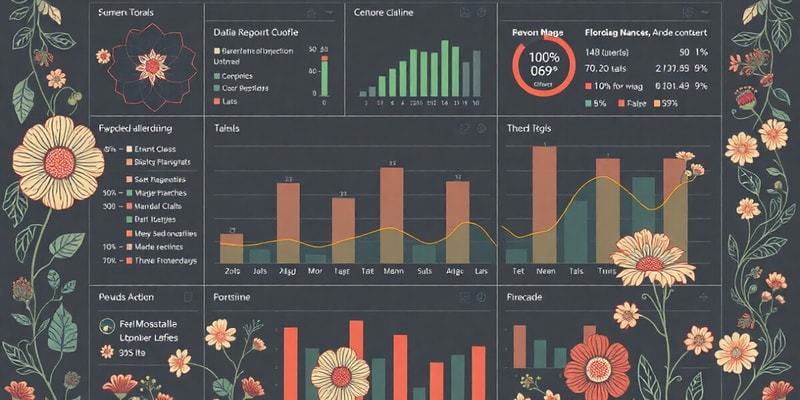Podcast Beta
Questions and Answers
What is the primary purpose of aggregation in data analytics?
Aggregation involves examining each data point individually.
False
Which aggregation method would you use to determine the total sales?
Sum
In data analytics, the highest value from a data set is referred to as the _____ value.
Signup and view all the answers
Match the following aggregation methods with their definitions:
Signup and view all the answers
What is the first step in creating a new dashboard?
Signup and view all the answers
Tableau allows worksheets and associated elements to overlap on the dashboard.
Signup and view all the answers
What section is used to give a title to your story?
Signup and view all the answers
To add sheets to the dashboard, you must drag them into the ______ space.
Signup and view all the answers
Match the following components of a dashboard with their descriptions:
Signup and view all the answers
Which of the following is NOT a component found in a blank dashboard?
Signup and view all the answers
What must you select from the drop-down menus to create a new story?
Signup and view all the answers
What feature of the Data Source tab allows you to see how data tables relate to each other?
Signup and view all the answers
Dimensions in Tableau contain numeric values that can be measured.
Signup and view all the answers
What are the two types of values you must select to create a visualization in Tableau?
Signup and view all the answers
In Tableau, measures are displayed in ______ color.
Signup and view all the answers
Match the following elements with their roles in Tableau:
Signup and view all the answers
What does aggregating data mean in Tableau?
Signup and view all the answers
The workbook interface in Tableau shows data fields on the right side.
Signup and view all the answers
What can be done in the Data Source interface after connecting datasets?
Signup and view all the answers
The features required to create visualizations are found in the ______ interface.
Signup and view all the answers
What must be done to change the name of a worksheet in Tableau?
Signup and view all the answers
Study Notes
Connecting Data
- You can connect data sources from various locations, including local files and servers.
- After connecting datasets, you can clean and integrate them for deeper insights.
Data Source Tab
- After loading a dataset, a Data Source tab appears.
- The Data Source tab provides features for interacting with the connected dataset(s).
- You can see how data tables and variables relate and modify basic data features.
Creating Data Visualizations
- Workbooks provide the tools to create visualizations.
- Data variables appear on the left side of the workspace.
- Visualizations are found on the right side under the “Show Me” section.
- You can rename worksheets by double-clicking them.
Visualizations: Selecting Variables and Show Me
- Select data variables to include in your visualization.
- Tableau will highlight compatible visualizations in the “Show Me” section.
- Both descriptive values (dimensions) and metric values (measures) are needed for effective visualizations.
Important Information About Data Variables
- Excel or CSV data source columns are shown as data fields in Tableau.
- Excel or CSV data source sheets are shown as data tables.
- Each data field is automatically assigned a data type (e.g., integer, string, date), and a role (either a discrete dimension or a continuous measure).
Understanding Dimensions and Measures
- Dimensions categorize, segment, and provide detail in the data.
- They affect the level of detail in visualizations and are colored blue in Tableau, creating headers for views.
- Measures contain numeric values that quantify dimensions.
- Measures are aggregated by default (e.g., summed), and are colored green in Tableau, creating axes for views.
Aggregation in Data Analytics
- Aggregation is a way of summarizing large sets of information.
- Examples include:
- Sum: Adding up all values (e.g., total sales)
- Average: Finding the middle value (e.g., average amount spent)
- Count: Counting occurrences (e.g., number of receipts)
- Max/Min: Finding the highest or lowest value (e.g., most expensive item)
Continuous and Discrete Fields in a View
- Continuous fields create horizontal or vertical axes (e.g., Quantity field in Example 1).
- Discrete fields create horizontal headers (e.g., Quantity field in Example 2).
- The choice of continuous or discrete determines how data is visualized.
- The role of a variable can be changed in Tableau if needed.
Measures and Aggregation
- When a measure is added to a view, it is automatically aggregated.
- The type of aggregation depends on the type of visualization.
- Always review and adjust the aggregation type as needed.
Studying That Suits You
Use AI to generate personalized quizzes and flashcards to suit your learning preferences.
Related Documents
Description
This quiz covers key concepts in connecting data sources, cleaning datasets, and creating visualizations using Tableau. Understand how to interact with data variables and utilize the 'Show Me' feature for effective visual representations. Perfect for beginners looking to improve their data analysis skills.




